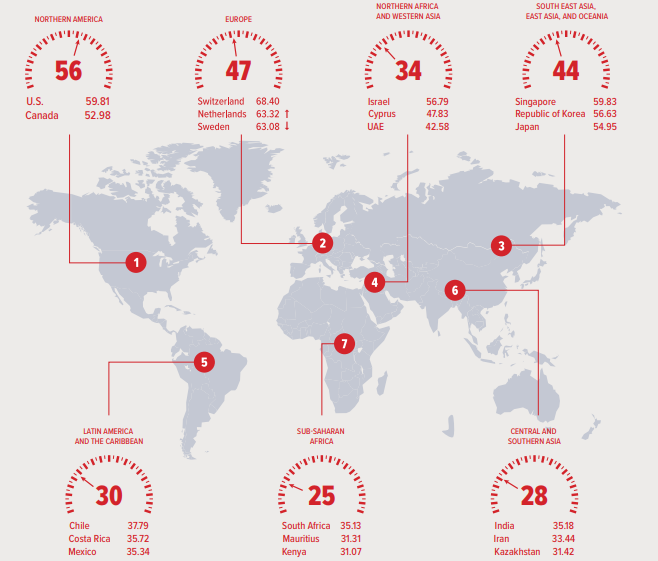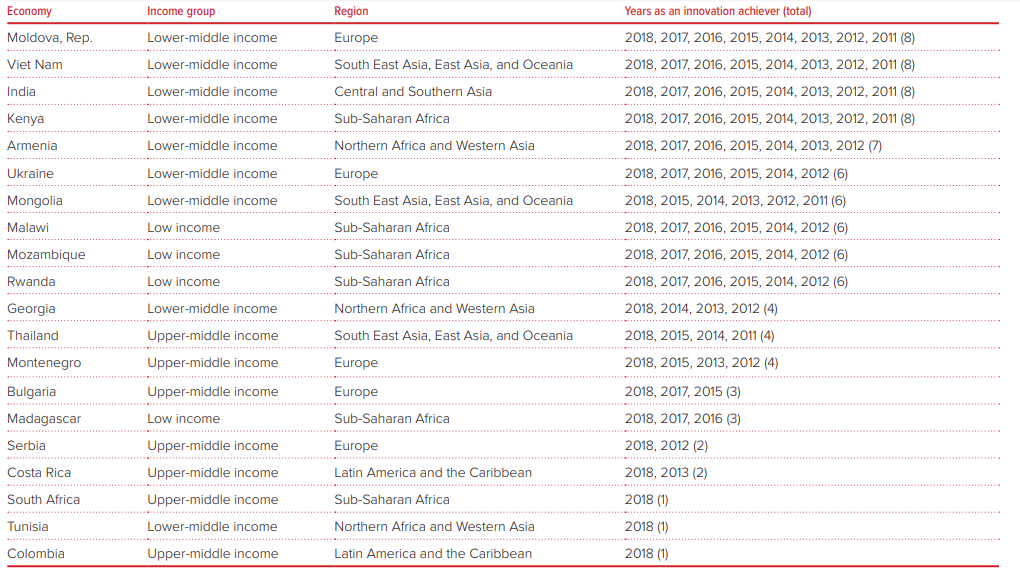Summary:
- European nations are once again dominating the leading positions in the latest annual version of the Global Innovation Index, released this week;
- The top ten in 2018 remains the same as last year, the first time in history that this has happened, with Switzerland ranked number one for the eighth consecutive year;
- North America and Europe are the top performing regions, but Asia is on the rise with its leading innovator Singapore climbing up into the global top five;
- Moldova, Vietnam, India and Kenya cited as strongest innovation achievers outperforming in relation to their development in each of the last eight years.
The index, this year dedicated to the theme of 'Energizing the World with Innovation', is co-published by Cornell University, business school INSEAD and the World Intellectual Property Organization, an agency of the United Nations. Now on its eleventh edition, it is based on 80 different parameters which together shows each country's ability to innovate new technologies and put them into use. It measures a country's innovation performance based both on its innovation inputs (such as regulatory environment, higher education, R&D and infrastructure) and its innovation outputs (such as online creativity and knowledge creation). The more diversified a country's economy, especially a high-income economy, the more innovative it appears in the ranking.
The top ten in 2018 remains the same as last year, the first time in history that this has happened, but there has been some movement in positions. Six of the top ten come from the European Union (a figure that will fall to five after Great Britain's exit in spring 2019), which remains an important force for innovation, especially in education, R&D expenditures, intellectual property filings and high-tech manufacturing output, according to the index.
CHART - Every year, the Global Innovation Index ranks the innovation performance of 126 economies around the world. Despite the USA slipping down the rankings this year, North America remains the top innovation region of the world by GII score Source: Global Innovation Index 2018
Source: Global Innovation Index 2018
Switzerland remains on top for the eighth year in a row, with considerably improved R&D expenditures continuing to feed its dominance, according to the report's authors. The Netherlands is ranked second, up from third in 2017, and excels in business sophistication and online creativity, swapping places with Sweden, which has slipped to third. The United Kingdom has moved up two places from fifth to third.
Singapore, one of the two non-European nations in the top ten, moved up from seventh to fifth after especially scoring well across the political stability and safety, market capitalisation and high-tech exports indicators. It is also home to the Solar Energy Research Institute of Singapore (SERIS), a research institute focused on contributing to global sustainable development and the solarisation of Singapore, noted the study.
The United States of America, the other non-European in the top ten, moved in the opposite direction - down from fourth to sixth - after losing ground across several pillars, including infrastructure. Almost all of the Top 25 innovating nations being classified as high-income economies, with China, an upper-middle income economy, the only exception.
It is clear that Northern America and Europe fare best amongst regions in the index, but Asia is making strong progress. China, which joined top 25 in 2016, rose to 22nd last year, is now ranked 17th. This indicates improvements in several factors, including high-tech imports and quality of publications, according to the report. The country was actually ranked first or second in terms of research and development expenditures and the number of researchers, patents and publications.
Overall, Southeast Asia, East Asia and the Oceania region showed the most progress compared to other regions, driven by the Association of Southeast Asian Nations. ASEAN progressed in innovation and socio-economic development indicators, according to the report. Elsewhere, Latin America and the Caribbean continues to show potential, but is making slow progress with Mexico, Colombia and Costa Rica the star performers.
The report also highlight some strong individual performers in sub-Saharan Africa with six out of 20 'innovation achievers' (those countries that outperform on innovation in relation to their development) from this region - Kenya, Rwanda, Madagascar, Malawi and Mozambique have actually been on this list at least three times in the past eight years.
CHART - Moldova, Vietnam, India and Kenya are the strongest innovation achievers outperforming on innovation in relation to their development in each of the last eight years Source: Global Innovation Index 2018
Source: Global Innovation Index 2018
The co-authors of the report says its observations can be summarised in seven key findings…
- Becoming optimistic about global innovation and growth is possible;
- Continued investments in breakthrough energy innovations are essential for global growth and to avert an environmental crisis;
- China's rapid rise shows the way for other middle-income economies;
- Richer economies, with more diverse industry and export portfolios, are likelier to score high in innovation;
- Focusing on translating innovation investments into results is key;
- Strong regional innovation imbalances persevere, hampering economic and human development;
- Most top science and technology clusters are in the US, China, and Germany; Brazil, India, and Iran also make the top 100 list.
WANT MORE? Download the Global Innovation Index 2018
The Global Innovation Index provides detailed metrics about the innovation performance of 126 countries which represent 90.8% of the world's population and 96.3% of global GDP. Its 80 indicators explore a broad vision of innovation, including political environment, education, infrastructure and business sophistication.